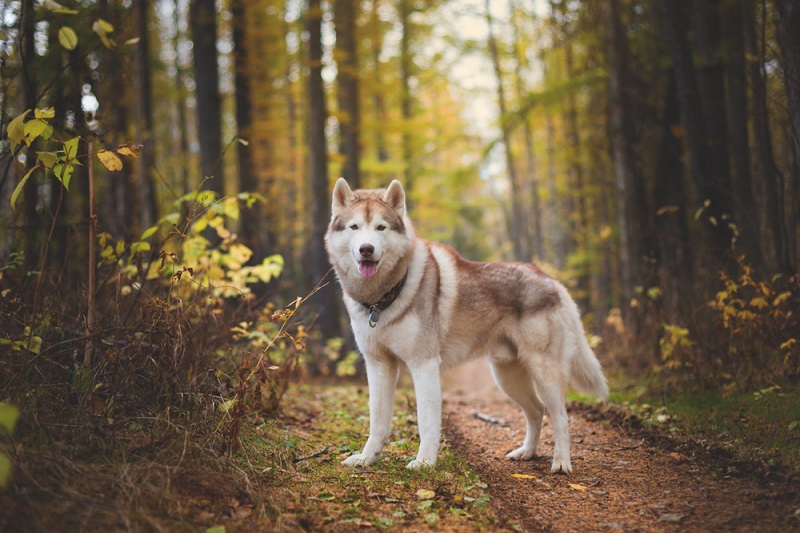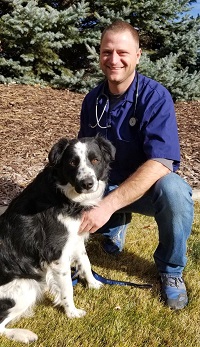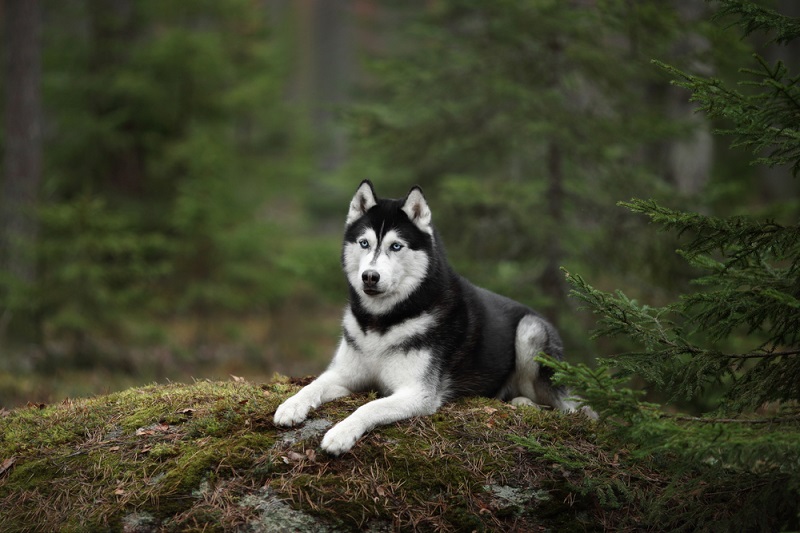From rich chocolatey browns to the snowiest whites, huskies come in a rainbow of beautiful shades. However, there’s more than fur that meets the eye. Underneath that thick hair lies your siberian husky’s skin, a vital organ in their physical health.
Like many dogs, huskies are susceptible to a range of health issues. This breed may be able to handle cold weather, but a siberian husky’s skincan also suffer from certain diseases, conditions, or problems if ignored. With the right care, you can prevent your pup from developing or suffering from these typical husky skin problems.
Whether you’re a hopeful or long-time husky owner, stay informed with our guide on the most common husky skin problems, as well as their symptoms and treatment options.
#1 Zinc-Responsive Dermatosis
If you mention “husky skin problems” to a veterinarian, they would probably first bring up zinc-responsive dermatosis. This treatable condition occurs when a husky dog has insufficient levels of zinc, a vital mineral. If prolonged, a zinc deficiency can create lesions on the skin (a.k.a., dermatosis), as well as a host of other symptoms for your husky pup.
Causes
There’s no one-size-fits-all cause behind low zinc levels or zinc-responsive dermatosis. In most cases, you can categorize the cause of this condition into three clinical types:
- Type 1 – Common in Alaskan breeds (including huskies), type 1 zinc-responsive dermatosis is the result of a poor genetic capability to absorb zinc in the digestional tract.
- Type 2 – Large dog breeds may eat food formulas with more phthalates and calcium, which bind to zinc and block absorption. This is more common in large dog breeds like Great Danes, German Shepherds, and Doberman Pinschers.
- Type 3 – When a dog fails to eat enough zinc through diet they may develop type 3 zinc-responsive dermatosis. This usually happens for dogs eating low-quality dog foods or an inadequate diet.
Symptoms
Zinc is an incredibly important mineral for dogs and humans, supporting the immune system, cell metabolism, skeletal-muscular system, and more. If your dog’s zinc deficiency goes ignored, it can lead to dermatosis (any skin lesions) and other serious symptoms like:
- Red and crusty skin around the mouth, ears, and nose
- Alopecia (hair loss)
- Itchy and red eyes (which could be a symptom of other husky eye problems)
- Thickened skin on joints
- New bacterial or yeast infections
- Depression
- Weight loss
- Diarrhea
- Stunted growth
- Dull hair
Treatment
Fortunately, this skin condition is treatable. Zinc-responsive dermatosis treatment is broken into two parts:
- Alleviating any symptoms or secondary infections
- Achieving normal zinc levels
Depending on the dermatosis symptoms, affected siberian huskiesmay need anything from topical antimicrobial sprays to eye drops. Similarly, raising zinc levels depends entirely on the cause of this condition. For dogs more prone to Type 1 (such as huskies) or Type 3, zinc supplementation through diet, pills, or intravenous methods can help. Type 2 zinc-responsive dermatosis cases may need to alter their diet to include fewer zinc-binding substances.
#2 Pemphigus Foliaceus
Pemphigus foliaceus is an autoimmune disease—a lifelong skin condition in which the body’s immune system attacks healthy cells. With pemphigus disorders, the immune system attacks the connective tissue between skin cells, leading to a range of skin issues and lesions. It‘s most common in older huskies over four years old, but huskies can develop this condition at any age.

Causes
If pemphigus foliaceus belonged to a book genre, it would be filed under “Mystery.” The causes of this skin disease are far and wide, making its origins difficult to trace. A case of pemphigus foliaceus can be genetic, environmental, a mix of causes, or even have no certain cause (also known as an idiopathic condition).2
For older huskies and other older dogs, any of the following inflammatory causes may trigger a pemphigus foliaceus outbreak
- Breed disposition
- Viral infections
- UV rays (sunlight)
- Drugs
- Allergies
Symptoms
Since pemphigus foliaceus affects the tissue between skin cells, it mostly creates skin-related symptoms. Severe cases may see hair loss, scabs, ulcers, crusts, and open sores around the face.2 The worse the case becomes, the more it may spread to other body parts. If left untreated, these lesions could develop bacterial or viral infections.
Treatment
Like most autoimmune disorders, there is no cure for pemphigus foliaceus. However, there are routine care treatments to soothe your pup’s symptoms or flare-ups. Once a veterinarian determines a possible cause, they could help your husky by providing:2
- Antibiotics or antivirals for any infections
- Alternative drugs (if current medications create flare-ups)
- Allergy medications
- Sunblock for infected areas
- Unscented and gentle cleansers
Most importantly—canine pemphigus foliaceus is a permanent skin problem. Once your precious husky develops this condition, it’ll have it for life. But fortunately, forming a long-term plan with a veterinarian professional can help your dog maintain a high quality of life and avoid any sustained suffering or irritation through routine care.
#3 Allergies
When the pollen count goes up, you’re not the only one whose nose runs or whose skin becomes itchy with hives. Dogs can develop allergies to countless substances, from grass to dust mites. This can lead to some serious allergic dermatitis or atopy—or the bothersome skin allergy symptoms .
Huskies aren’t the most sniffly dog on the block, but they’re still prone to allergies (especially of the food variety). Let’s dive into the basics of canine allergies and how they affect the skin.
Causes
Before discussing the causes of canine allergies, it’s important to know the definition of an allergy. Allergies are an autoimmune reaction, where the immune system overreacts to a particular allergen or substance. With canine allergies, this triggering “substance” or cause behind an allergy can be:
- Insects
- Dust mites
- Plants
- Pollens
- Mold spores
- Proteins (soy, beef, etc.)
- Household chemicals
- Medications
Symptoms
Canine allergy symptoms are like a prize wheel—you could end up with anything! A food allergy may leave your dog with diarrhea and vomiting, while mold spores could leave them with coughing or shortness of breath. When it’s a skin allergy, it could cause any of the following allergic dermatitis symptoms:
- Itching
- Redness
- Greasy appearance
- Tough texture
- Excess scratching
- Yeasty smell
- Secondary infections (bacterial, fungal, etc.)
Typically, dermatitis symptoms will appear on your dog’s ears, feet, underbelly, armpits, or muzzle. However, don’t rule out any other areas.
Treatment
Like all autoimmune diseases—and like most human allergies—canine allergies are for life. However, they’re incredibly treatable—and even preventable. Depending on the severity, a veterinarian may recommend any of these allergy treatments:
- Immunomodulatory medications – If your husky is mildly allergic to everyday substances (grass, dust mites, etc.), then medication may be a good solution. You could sneak a daily immunomodulatory pill into their meals, or you could give injections every 4 to 10 weeks.
- Infection treatments – When allergies wound the skin, your dog has a higher chance of developing infections. A veterinarian will offer antibiotics, antifungals, or antimicrobial treatments to heal any infections.
- Hyposensitization therapy – Just like your pup, allergies can be “trained.” Hyposensitization therapy involves injecting your dog with small amounts of their trigger allergens. Over months, this can decrease symptoms like itchiness by up to 80%.
- Hygiene – A good skincare routine can do wonders for your dog’s complexion and allergy symptoms. Regular bathing, medicated shampoos, and soothing conditioners can help heal inflamed or infected skin.
#4 Demodectic Mange
Demodectic mange is a common skin problem for dogs—and your husky is no exception. Demodectic mange (or demodex) is one of two mange diseases, both of which are caused by parasites on your dog’s skin. For huskies, demodectic mange is the more common disease—and luckily, this skin infection is very treatable.
Causes
This parasitic disease is caused by microscopic mites (demodex canis) that live within your dog’s hair follicles. However, most dogs have a few of these pesky neighbors on their skin at all times. It’s only when a weak immune system allows these mites to flourish that problems begin. The result? Demodectic mange.
Since the immune system controls this mite population, affected siberian huskies with weaker immune responses are more susceptible to mange. This includes:
- Dogs less than 18 months old
- Older dogs
- Dogs with other diseases or illnesses
- Certain breeds with weaker immune systems
Symptoms
Demodectic mange symptoms can be local (in one spot) or general (all over the body). Typically, these symptoms will include:
- Hair loss
- Skin redness
- Scaling or crusts
- Lesions
- Skin infection
Treatment
Thankfully, demodectic mange is only skin deep. However, you’ll often still need professional guidance to eliminate these pesky mites. To treat this condition, see if your veterinarian would recommend any of the following:6
- Hair cuts
- Regular bathing
- Medicated shampoos or conditioners
- Topical or oral mite control medications (selamectin, imidacloprid-moxidectin, etc.)
To learn more about how to treat mange in dogs, you can check our in-depth guide and products.
Tips for Husky Skin Care
If you own a husky, you already know the answer to the question: do huskies shed? While heir beautiful fur isn’t exactly low-maintenance, you don’t need much to keep your husky’s skin happy.
To start, all you need is a small doggy care toolkit and some strong habits to soothe your pup. Take these tips to preserve and treat your husky’s dry skin at home:
- Bathe your pup with a medicated shampoo, but only when they naturally smell or accumulate dirt.
- Brush their hair twice per week, or even more if necessary.
- Apply antimicrobial products to wounds, such as sprays or gels.
- Make regular grooming appointments, especially during summertime or hot weather.
- Serve veterinarian-approved food to your dog to provide all necessary nutrients.
Vetericyn: Taking Pet Care Beyond Skin Deep
Beautiful and bounding with energy, huskies make for incredible companions. Whether you’re a current or hopeful husky parent, these dogs deserve all the love and care in the world—and Vetericyn is here to help you provide it.
At Vetericyn, we believe animal care should be safe and effective. That’s why our products are non-toxic, research-backed, and trusted by major carriers like Amazon, Petco, and Chewy. From pet skin care to eye and ear care, Vetericyn is here to ensure your pet is a healthy and happy part of your family.
 Reviewed by Dan Richardson, Veterinarian
Reviewed by Dan Richardson, Veterinarian
Dan Richardson has been a practicing veterinarian for over 10 years. He specializes in surgery and orthopedics. Dan is originally from rural western Nevada and attended the University of Idaho for undergraduate study and Oregon State University for Veterinary School. The Richardson Family enjoys camping and spending time on the water fishing, paddle boarding, or digging their feet in the sand somewhere warm.
Sources:
- American Kennel Club. Mange in Dogs: What You Need to Know. https://www.akc.org/expert-advice/health/mange-what-you-need-to-know/
- PetMD. Atopic Dermatitis in Dogs: Causes, Symptoms, and Treatments. https://www.petmd.com/dog/conditions/skin/c_dg_atopic_dermatitis
- VCA Animal Hospital. Allergies in Dogs. https://vcahospitals.com/know-your-pet/allergy-general-in-dogs
- VCA Animal Hospital. Demodectic Mange in Dogs. https://vcahospitals.com/know-your-pet/mange-demodectic-in-dogs
- VCA Animal Hospital. Pemphigus in Dogs. https://vcahospitals.com/know-your-pet/pemphigus-in-dogs
- VCA Animal Hospital. Zinc-Responsive Dermatosis in Dogs. https://vcahospitals.com/know-your-pet/zinc-responsive-dermatosis-in-dogs
